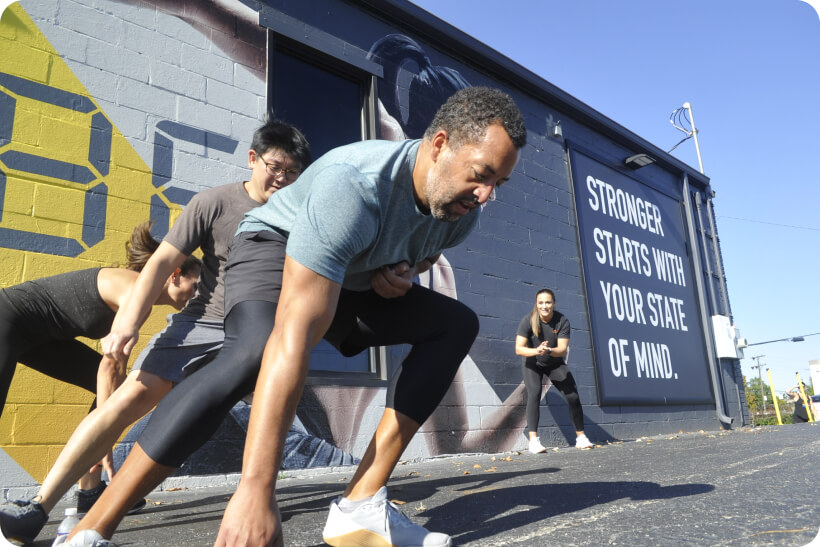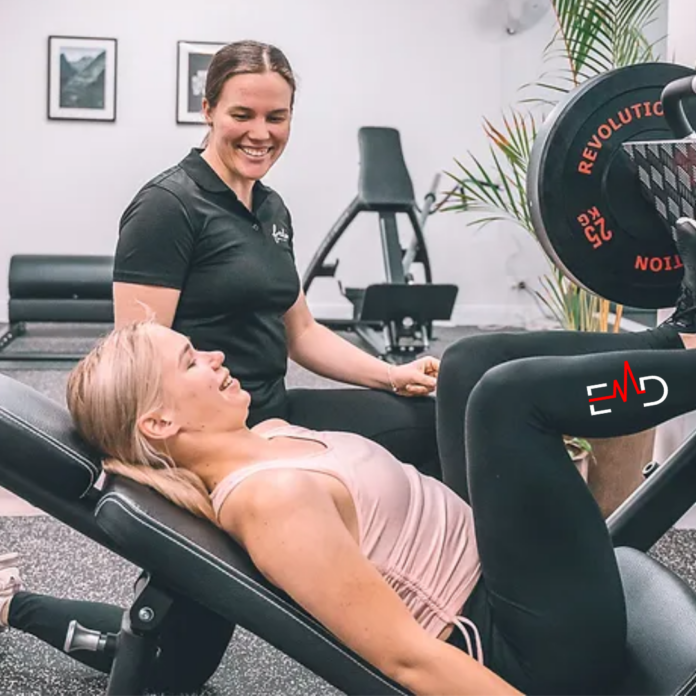Exercise Daily – Fitness often takes center stage in pursuing a healthier lifestyle. However, the path to fitness freedom can be daunting, especially for those who struggle to find a routine that resonates with them. The key to unlocking fitness freedom lies in understanding your unique fitness personality, setting realistic goals, creating a personalized routine, and overcoming challenges.
The Journey to Fitness Freedom
Fitness freedom is finding your unique path to wellness and forging a fitness journey that brings you joy and satisfaction. It means discovering the workouts, nutrition plans, and lifestyle habits that work for you rather than unthinkingly following trends or someone else’s formula.
Fitness freedom is not a destination but an ongoing journey of self-discovery and personal growth. It’s about balancing physical activity and overall well-being, where exercise becomes an enjoyable and integral part of your life.

Discovering Your Unique Fitness Needs
Before you can find your perfect fitness routine, it’s essential to understand your unique needs and goals. Take time to assess your current fitness levels, any injuries or limitations, and what you hope to achieve through your fitness journey. This information will help you find the right workouts and nutrition plans for your body and lifestyle.
With so many different workout options available, it can be overwhelming to choose the right one. The key is to experiment with various exercises, classes, and activities to find what you enjoy and what gives you results. Consider your fitness goals, preferences, and schedule when selecting a workout, and don’t be afraid to mix it up to keep things interesting.
Your Fitness Personality
The first step towards fitness freedom is understanding your fitness personality. Are you an active person who thrives on high-intensity workouts, or do you prefer low-impact activities that allow you to connect with your body and mind? Do you enjoy working out alone or in a group setting? Identifying your preferences will help you tailor your fitness routine to your unique personality.
Active vs. Sedentary Lifestyle
Choosing between an active and passive lifestyle can significantly impact your overall health and well-being. An active lifestyle promotes physical fitness, reduces the risk of chronic diseases, and improves mental health. On the other hand, a sedentary lifestyle can lead to weight gain and increased risk of heart disease, stroke, type 2 diabetes, and depression.
Intrinsic vs. Extrinsic Motivation
Motivation plays a crucial role in maintaining a consistent fitness routine. Intrinsic motivation, driven by internal factors such as enjoyment and personal satisfaction, is more sustainable than extrinsic motivation, which relies on external rewards or punishments. Finding activities that genuinely enjoy and align with your values will help you stay motivated in the long run.
Individual vs. Group Fitness
Some people thrive in the camaraderie of group fitness classes, while others prefer the solitude and flexibility of individual workouts. Both approaches have their merits. Group fitness can provide motivation, accountability, and social interaction, while individual workouts allow for a more personalized and tailored approach.
Outdoor vs. Indoor Fitness
The choice between outdoor and indoor fitness depends on your preferences and lifestyle. Outdoor activities offer fresh air, scenic views, and a connection with nature, while indoor workouts provide convenience, climate control, and access to specialized equipment.

Setting Realistic Fitness Goals
Setting realistic fitness goals is essential for staying motivated and avoiding burnout. The SMART criteria (Specific, Measurable, Achievable, Relevant, and Time-bound) can help you create goals tailored to your unique situation and abilities.
Short-Term vs. Long-Term Goals
A balanced fitness goal-setting approach involves a combination of short-term and long-term goals. Short-term goals provide a sense of progress and motivation, while long-term goals keep you focused on the bigger picture.
Balancing Challenge and Enjoyment
Finding the right balance between challenge and enjoyment is crucial for maintaining a sustainable fitness routine. Pushing yourself outside your comfort zone is essential for progress, but choosing activities you genuinely enjoy is equally important. This will help you stay motivated and consistent over time.
Creating a Personalized Fitness Routine
A personalized fitness routine aligns with your unique preferences, goals, and lifestyle. It should include a variety of activities that you enjoy, challenge you appropriately, and allow for gradual progression.
Choosing Activities, You Love
The key to sticking to a fitness routine is choosing activities that you genuinely enjoy. If you find an activity boring or unpleasant, you’re less likely to make it a regular part of your life. Explore different types of exercise until you find something that resonates with you.
Incorporating Variety
Variety is essential for keeping your fitness routine interesting and preventing boredom. Incorporate a mix of cardiovascular exercises, strength training, flexibility exercises, and balance exercises to target different muscle groups and aspects of fitness.
Progressing Gradually
Gradual progression is key to avoiding injuries and burnout. Start with a manageable level of intensity and duration, and gradually increase the challenge as you become stronger and more conditioned.
Listening to Your Body
Listening to your body is crucial for staying safe and injury-free. Pay attention to signs of fatigue, pain, or discomfort. If something doesn’t feel right, stop the activity and consult with a healthcare professional if necessary.

Overcoming Fitness Challenges
Fitness challenges are inevitable, but they can also be opportunities for growth and resilience. Here’s how to navigate common fitness challenges:
Dealing with Plateaus
Plateaus are periods of stagnation in fitness progress. They can be frustrating but are also a normal part of the fitness journey. To overcome a plateau, try changing your workout routine, increasing the intensity or duration of your workouts, or incorporating new activities.
Staying Motivated During Setbacks
Setbacks are a natural part of life, and fitness is no exception. Injuries, illnesses, or life events can disrupt your routine. The key is to stay positive, focus on what you can control, and gradually work your way back to your fitness goals.
Seeking Support from Others
Support from friends, family, or a fitness community can be invaluable in overcoming fitness challenges. Share your goals, struggles, and successes with others who understand your journey. You can also consider working with a personal trainer or fitness coach for personalized guidance and encouragement.
The Benefits of Fitness Freedom
Fitness freedom is engaging in physical activities that align with your personal preferences, goals, and schedule without feeling restricted or bound by external factors. Embracing fitness freedom can unlock many benefits that positively impact your physical, mental, and emotional well-being.
1. Improved Physical Health:
As part of a fitness freedom routine, regular exercise strengthens your muscles and bones, improving overall physical fitness. It enhances cardiovascular health, reducing the risk of chronic diseases such as heart disease, stroke, and type 2 diabetes. Additionally, it promotes flexibility, balance, and coordination, supporting an active and fulfilling lifestyle.
2. Enhanced Mental Well-being:
Exercise has been scientifically proven to impact mental health positively. It effectively reduces stress, anxiety, and depression while elevating mood and boosting cognitive function. Regular physical activity can improve memory, focus, and concentration, enhancing overall mental well-being and productivity.
3. Increased Confidence and Self-Esteem:
Setting and achieving fitness goals can instill a sense of accomplishment, boosting self-confidence and improving overall self-esteem. As you progress in your fitness journey, you witness your body’s transformation and increased abilities, leading to a more positive self-image and a stronger sense of self-worth.
4. Improved Sleep Quality:
Regular exercise can significantly enhance sleep quality. It helps you fall asleep faster, sleep more soundly, and wake up refreshed and rejuvenated. By promoting the release of endorphins, which have mood-boosting and pain-relieving effects, exercise creates a conducive environment for restful sleep.
5. Stronger Social Connections:
Fitness freedom often involves participating in group fitness activities or joining a fitness community. These social interactions provide opportunities to connect with like-minded individuals with similar interests and goals. Group workouts, fitness classes, and outdoor adventures can foster friendships, support networks, and a sense of belonging, contributing to overall well-being.

Conclusion
Fitness freedom is a journey of self-discovery, personal growth, and empowerment. Understanding your fitness personality, setting realistic goals, creating a personalized routine, and overcoming challenges can unlock the door to a healthier, happier, and more fulfilling life. Embrace fitness freedom, find your fit, and find yourself.
FAQs – Fitness Freedom: Find Your Fit, Find Yourself
What is fitness freedom?
Fitness freedom is when exercise becomes an enjoyable and integral part of your life, leading to improved physical, mental, and emotional well-being.
How can I find my fitness personality?
Reflect on your preferences, strengths, and weaknesses. Consider what activities you enjoy, what motivates you, and what environment you prefer for working out.
How do I set realistic fitness goals?
Use the SMART criteria (Specific, Measurable, Achievable, Relevant, and Time-bound) to create goals tailored to your unique situation and abilities.
How can I create a personalized fitness routine?
Choose activities you enjoy, incorporate variety, progress gradually, and listen to your body. Consider working with a personal trainer or fitness coach for personalized guidance.
How can I overcome fitness challenges?
Deal with plateaus by changing your routine or increasing intensity. Stay motivated during setbacks by focusing on what you can control and gradually working your way back to your goals. Seek support from friends, family, or a fitness community.





